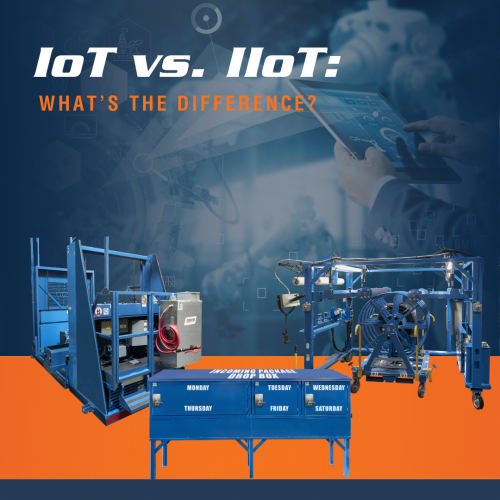We use cookies to make your experience better. To comply with the new e-Privacy directive, we need to ask for your consent to set the cookies. Learn more.
IoT vs. IIoT: What’s the Difference?

These two terms — IoT vs. IIoT — appear more or less interchangeably in the industrial press. But are they essentially the same thing? To answer that question, we need to review what we mean when we talk about the Internet of Things and its industrial applications.
Definitions: IoT and IIoT
The Internet of Things is the connection of machines and products to the internet through embedded wireless devices. In the consumer space, this technology provides convenience: Smart watches track biomarkers and count daily footsteps; smart thermostats allow homeowners to adjust temperatures remotely; and smart refrigerators alert us when we’re low on milk, for instance.
When we apply this connected technology to industrial processes, we often call the system the Industrial Internet of Things, or industrial IoT, or just IIoT.
The Industrial Internet of Things is simply a subcategory of IoT. The use of IoT in industrial settings (such as manufacturing, agriculture, health care, or supply chains) incorporates these intelligent devices to collect and share data, streamlining mission-critical processes like maintenance, inventory, and productivity tracking.
For instance, the IIoT-enabled BHS Operator Aboard Battery Extractor includes smart sensors in critical internal systems. If the unit shifts off level, sensors notify operators and managers, allowing them to fix the problem before damage occurs. If oil overheats, or filters clog, the system alerts users, who can then conduct an oil change.
This sort of real-time monitoring leads to an alternative to preventive maintenance schedules: condition-based maintenance. Combined with advanced algorithms that study data from multiple systems to predict failure states before they happen, IIoT machinery allows another advanced technique: predictive maintenance. Both maintenance strategies give users more flexibility in scheduling maintenance, prevent unnecessary downtime, and protect assets from damage caused by unrecognized internal conditions.
Key Differences between IoT and IIoT
One major difference between IoT and IIoT is the speed at which the technology is being incentivised and applied. In short, IIoT operates with higher stakes than consumer IoT products, leading to more widespread adoption.
While IoT is more consumer-facing, focusing on wearable smart items or household products, IIoT automation is used within high-stakes industries. Procedural failures within the health care or supply chain industries can create serious problems. IIoT solutions can help reduce these risks, making them even more important than their IoT equivalents among business-to-consumer products.
IIoT Solutions from BHS, Inc.
BHS offers a range of IIoT products for material handling applications. We’ve already mentioned the Operator Aboard Battery Extractor (BE) — a fully connected battery change-out machine for high-volume users. For more operational improvements in the battery room, add BHS Fleet Tracker to a BE system.
Fleet Tracker is a digital management solution that handles all the data needs of the electric forklift fleet. It selects charged batteries, prompts users for maintenance tasks, updates usage and fleet-health information, generates detailed reports, and more. The full system includes software for asset-tracking and analysis, a touch-screen HMI for operators, a cloud-based portal for managers, and all required hardware, including a lightweight scanner for instant data entry.
Outside the battery room, the IIoT-enabled Will Call Dropbox is a parcel locker which features digital smart locks, controllable by a remote user interface, which can allow after-hours deliveries or pick-ups. For electrical suppliers, the IIoT-enabled Spool Winding Trolley (SWT-IIOT) is a stand-alone cable winding solution with an integrated cable length counter and auto-stop functionality.
These products fall clearly under the umbrella of the Industrial Internet of Things, though they could also be described, more broadly, as IoT devices. The important thing to remember about IoT vs. IIoT is that they use the same range of technologies, just for radically different purposes.
